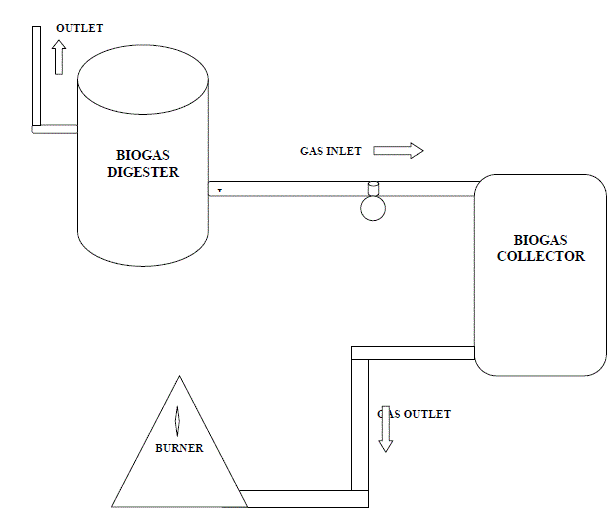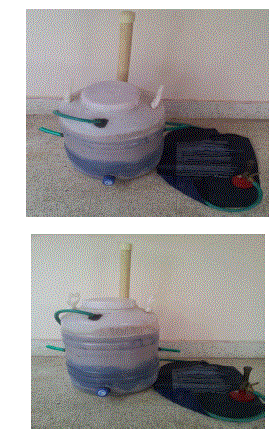ISSN ONLINE(2319-8753)PRINT(2347-6710)
ISSN ONLINE(2319-8753)PRINT(2347-6710)
Jyothilakshmi.R1, Dr. S.V. Prakash2, Vishal Kedia3
|
| Related article at Pubmed, Scholar Google |
Visit for more related articles at International Journal of Innovative Research in Science, Engineering and Technology
Biogas digesters are used to produce methane gas and the size of the digesters are commonly bigger in size. People who live in poor conditions and are familiar with the uses and the advantages of using methane gas wants to have a biogas digester at home for replacing the cooking gas as the ever increasing price of cooking gas is adding to their woes. Being in the densely populated city, Bangalore, the problem of domestic waste management is highly inefficient. There is a need for an efficient method to tackle this problem. Both the problems can be met with a residual clean energy output in the form of biogas through a portable biodigester which can be installed and moved at any place in every house with the help of minimum resources. The project involves the developing and analysis of the body shape of the digester to make it be more efficient to produce methane gas. It mainly concentrates on the economic aspect and will also concern about the structure strength, durability, ergonomic factor, convenience and flexibility of usage in different weather conditions. All the specifications must be verified to avoid materials and fund wasting. Overall process to design, develop and fabricate this digester required the skills of designing and fabrication and used all the basics knowledge of Static, Industrial Design and Manufacturing Technology. The objectives of this project are:  To fabricate a portable biodigester to be used in all weather conditions.  Consideration of economic and ergonomic factors with maximum efficiency in production of methane gas through domestic waste.
Keywords |
| Biodigester, Domestic Waste Management, Biogas, Household Biodigester. |
INTRODUCTION |
| One of the main environmental problems of today‘s society is the continuously increasing production of organic wastes. In many countries, sustainable waste management as well as waste prevention and reduction have become major political priorities, representing an important share of the common efforts to reduce pollution and greenhouse gas emissions and to mitigate global climate changes. Uncontrolled waste dumping is no longer acceptable today and even controlled landfill disposal and incineration of organic wastes are not considered optimal practices, as environmental standards hereof are increasingly stricter and energy recovery and recycling of nutrients and organic matter is aimed. Production of biogas through anaerobic digestion (AD) of animal manure and slurries as well as of a wide range of digestible organic wastes, converts these substrates into renewable energy and offers a natural fertiliser for agriculture. At the same time, it removes the organic fraction from the overall waste streams, increasing this way the efficiency of energy conversion by incineration of the remaining wastes and the biochemical stability of landfill sites. AD is a microbiological process of decomposition of organic matter, in the absence of oxygen, common to many natural environments and largely applied today to produce biogas in airproof reactor tanks, commonly named digesters. A wide range of micro-organisms are involved in the anaerobic process which has two main end products: biogas and digestate. Biogas is a combustible gas consisting of methane, carbon dioxide and small amounts of other gases and trace elements. Digestate is the decomposed substrate, rich in macro- and micro nutrients and therefore suitable to be used as plant fertiliser. |
| The production and collection of biogas from a biological process was documented for the first time in United Kingdom in 1895 (METCALF & EDDY 1979). Since then, the process was further developed and broadly applied for wastewater treatment and sludge stabilisation. The energy crisis in the early âÃâ¬Ãâ70s brought new awareness about the use of renewable fuels, including biogas from AD. The interest in biogas has further increased today due to global efforts of displacing the fossil fuels used for energy production and the necessity of finding environmentally sustainable solutions for the treatment and recycling of animal manure and organic wastes. Biogas installations, processing agricultural substrates, are some of the most important applications of AD today. In Asia alone, millions of family owned, small scale digesters are in operation in countries like China, India, Nepal and Vietnam, producing biogas for cooking and lighting. Thousands of agricultural biogas plants are in operation in Europe and North America, many of them using the newest technologies within this area, and their number is continuously increasing. In Germany alone, more than 3.700 agricultural biogas plants were in operation in 2007. |
DESIGN AND FABRICATION |
| A. Components |
| digester tank, inlet for feeding the kitchen waste, outlet for the digested slurry, gas collection and storage system |
| B. Materials required |
| Empty PVC cans 30ltrs capacity: 1 No. (to be used as digester tank) |
| M-seal or any water-proof adhesive |
| Gas collection bags |
| PVC Pipes |
| Valves |
| C. Tools Required |
| Welding tools to weld the pipes and disk into the digester tank. |
| A hack saw blade for cutting the pipes. |
| A sharp knife for cutting holes on the tank. |
| D. Production Process |
| 30 ltrs capacity PVC-can will act as the digester unit. |
| PVC pipes will be used for feeding the kitchen waste, guide pipe fixed with the digestion chamber and a pipe will be used as outlet for the slurry. |
| Here 3 holes are made, a smaller hole for gas delivery system, a hole for fixing the slurry outlet pipe and one hole for fixing the waste feeding pipe on the right side. Made these holes with the help of a sharp knife and hack saw blade. |
| Digestion tank is fitted with a central guide pipe and an outlet pipe for the slurry. |
| Two holes are cut through diametrically opposite side of the cylindrical body in the lower half of the can and a flexible pipe is introduced, forming loops inside the can and coming out of the other end. |
| Hot water can be made to flow through this loop of the pipe for maintaining the desired uniform temperature inside the biodigester in all weathers. |
 |
 |
EXPERIMENTAL DETAILS |
| Experiment was conducted on the fabricated biodigester of capacity 30 litres. |
| Slurry of cow manure in water was fed through the inlet until the digester is about 80% filled with slurry, and the slurry surface on both inlet and outlet did not leave holes by which the air can get into the digester. This was to ensure the anaerobic condition in the gas space inside the digester. After the first filling, both the inlet and outlet were covered and gas valve to the gas holder was opened. In the first 20 days, the gas holder expanded with produced gas. The first 20 days was the transient phase of the biogas production and it acted as a batch reactor. At the end of 20 days, the content of the gas holder was released as it did not burn due to the predomination of carbon dioxide. The next phase was started wherein the biodigester was fed periodically with slurry including kitchen and domestic waste from the MSRIT college canteen. After the digester was operational for several weeks after the initial filling, the pH value had reached the stable value of 6.5 that remained constant during the period of sampling. The temperature is constant between 35-40 during the day and 25-30 during the night. Therefore, those two parameters were considered as the constants with respect to the model development. Based on our field data, those two parameters did not fluctuate significantly in Bangalore Climate. |
 |
| A. Calculation (Cow Dung) |
| Step-I: Finding the amount of Total Solid (TS) in the slurry |
| TS= 8.5% of slurry = 0.085 X 20 kg = 1.7 kg |
| Step-II: Finding the amount of Volatile Solid (VS) in the slurry |
| VS= 0.8TS = 1.36 kg |
| Step III: Finding the biogas yield in terms of per kg of VS |
| The total amount of degradable material present in the VS is about 50% only |
| Thus, the VS used = 0.5 X 1.36 = 0.68 kg |
| Now, |
| 0.68 kg of VS gives 0.18 m3 of biogas |
| Therefore, 1 kg of VS will give |
| 0.018/0.68 = 0.264 m3 of biogas |
| Thus, the biogas yield is 0.264 m3/kg VS from Cow dung slurry. |
| B. Calculation (Domestic Waste) |
| Step-I: Finding the amount of Total Solid(TS) |
| TS= 10% of slurry = 0.1 X 10 kg = 1 kg |
| Step-II: Finding the Volatile Solid (VS) |
| VS= 0.8 X TS = 0.8 X 1 = 0.8 kg |
| Step III: Finding the biogas yield in terms of per kg of VS |
| The total amount of degradable material present in the VS is about 50% only |
| Thus, the VS used = 0.5 X .8 = 0.4 kg |
| Now, |
| 0.4 kg of VS gives 0.17 m3 of biogas |
| Therefore,` |
| 1 kg of VS will give 0.017/0.4 = 0.425 m3 of biogas |
| Thus, the biogas yield is 0.425 m3/kg VS from Domestic Waste slurry. |
CONCLUSION |
| The portable biodigester can be a boon for Bangalore household waste management and energy needs. Recent developments in household waste management of this city have proved to be insufficient. There is a dire need for some alternative and efficient method to solve this problem. At this juncture, our portable biodigester finds its way into the houses of this city. Being an efficient alternative way to produce a clean and economic form of energy, the miniature biogas production unit can installed at any place with the help of minimum financial resources. This digester helps in two ways: one is to reduce waste, and the other is to provide valuable energy. Although biodigesters have been used for many years, modernization is needed to overcome the drawbacks in the long run. The awareness by people of their technical issues, and governmental subsidy plans could provide even more benefits from household digesters. |
ACKNOWLEDGMENT |
| I express my sincere and whole hearted thanks to the Management of MSRIT, Dr. S.Y. KULAKARNI, Principal MSRIT and Dr. V RAVI, Head of Department - Mechanical Engineering, MSRIT, Bangalore, for their constant motivation and encouragement towards the success of this project. |
References |
|